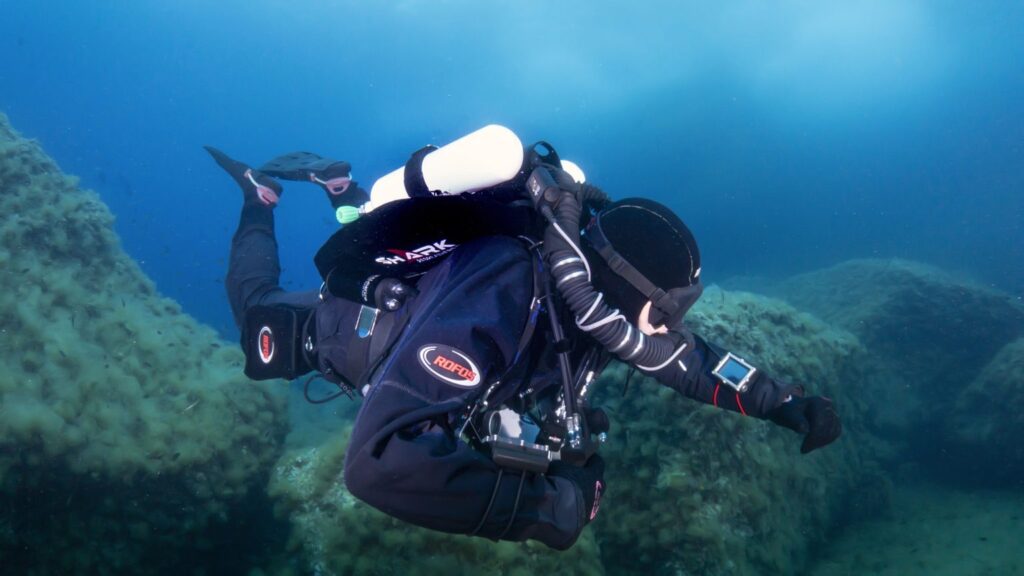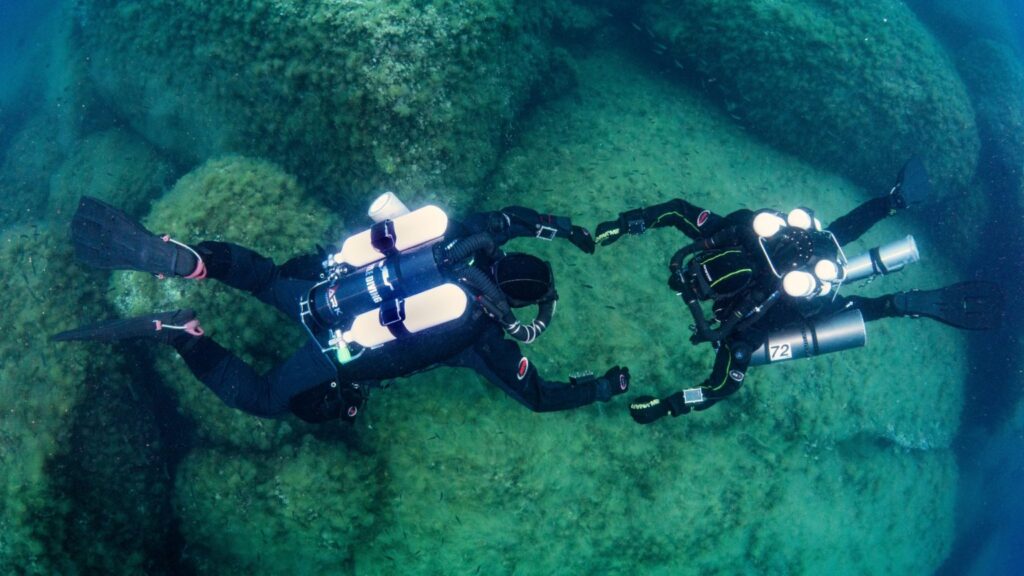Train with Instructor Trainer SDI/TDI Marco Alberti
The Shark Rebreather represents the latest generation of closed-circuit rebreathers (CCR), designed for divers seeking performance, reliability, and safety. Built in Belgium and CE-certified up to 40 metres (air diluent) and 100 metres (helium-based diluent), the Shark offers a versatile and advanced solution for both recreational and technical diving.

What Makes the Shark Rebreather Unique?
- The Shark stands out from other rebreathers for several innovative features, including:
- Rear-mounted, protected counterlungs, carefully designed to optimise gas flow and reduce breathing effort — among the lowest on the market.
- Combined manual and automatic oxygen and diluent injection at a single point inside the exhalation counterlung. This design ensures the gas mixes completely while passing through the scrubber before being analysed by oxygen sensors, guaranteeing the diver always breathes the analysed gas.
- Latest-generation technology, incorporating advanced materials and engineering, making the Shark one of the most modern and efficient rebreathers available today.
The unit is equipped with a Petrel 3 Shearwater computer for ppO2 monitoring and dive data management. A hybrid version with a solenoid and Shearwater electronic ppO2 setpoint controller is also available. For technical divers, it’s highly recommended to add a backup system, such as a HUD or Shearwater NERD.

Course Overview
The Shark Rebreather Course typically lasts 5 to 6 days, including a minimum of 8 dives of approximately one hour each.
The course includes:
- Full theoretical and practical training
- Teaching materials and absorbent for initial dives
- Unit configuration, operation, and maintenance procedures
Note: Additional costs such as dive fees, gas fills, and instructor travel (depending on location) are to be shared among participants.
If you are not already rebreather-certified, following manufacturer guidelines, you will initially receive a disabled unit with a critical component sent directly to your instructor until successful course completion.
Technical Features and Options
- Diluent and Oxygen Cylinders: Compatible with 2L or 3L cylinders, with standard 5/8” DIN valves for diluent and M26 valves for oxygen (as per CE regulations).
- Harness and Wing: Supplied with an adjustable high-quality harness and Halcyon rear wing. Compatible with other backplate systems using 11-inch hole spacing.
- Customisation: Possible to adapt different wings and harnesses to suit diver preference, though this may affect unit trim and breathing effort.
Maintenance and Consumables
- Annual maintenance: Approx. €300/year for regular servicing.
- Scrubber capacity: 2.5 kg of absorbent, typically lasting around 3 hours underwater (above 15°C).
- Recommended absorbents: Sofnolime 797, with Steramine or equivalent for disinfection, and Tribolube 71for O-rings.
- Sensors: Shark brand Molex oxygen sensors.
- Electronics batteries: Shearwater units require one AA battery and one 9V battery (Energizer or Duracell recommended).
- Scrubber refill cost: Approx. €15 per full charge, reusable for multiple dives depending on duration.
Basic maintenance is covered during the course. All extraordinary maintenance must be done by authorised service centres.

Safety and Design Considerations
The Shark rebreather is engineered to minimise water intrusion through smart design features like elevated scrubber placement and isolated expiratory counterlungs.
During the course, you will learn to:
- Properly set up and check the unit before dives
- Follow a comprehensive pre-dive checklist
- Understand and manage the unit’s key components and systems
Who is this course for?
The Shark Rebreather Course is suitable for:
- Experienced divers who want to start or advance in closed-circuit diving
- Divers aiming for technical diving and deeper exploration with helium mixes
- Those seeking the latest technology in rebreather diving
Note: Course price varies depending on the required certification level (recreational or technical).
Contact and Booking
For more details, pricing, and upcoming course dates, please contact:
Marco Alberti (Instructor Trainer SDI/TDI): +39 348 406 2144
Email: info@dgportofino.com
Take your diving to the next level with the Shark Rebreather — a perfect blend of innovation, safety, and performance.



